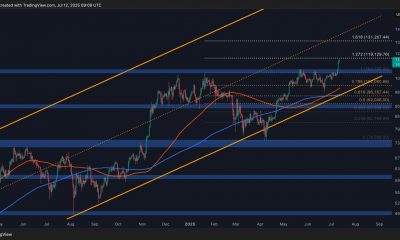Forex
U.S. stock index futures point to positive start to trading

Everyone understands US stock futures are explained. U.S. stock index futures and options are aiming for a positive start to the week of July 25 (ESU00: +0.33%), in anticipation of this week’s Fed policy meeting and earnings reports from some major companies that will help gauge the impact of a strengthening dollar and rising inflation.
U.S. stock index futures analysis
There will be plenty of catalysts this week, including reports from about 175 S&P500 companies, which make up nearly 50% of the index’s market capitalization; the FOMC decision on Wednesday; the preliminary Q2 GDP estimate, and the June personal income and spending statistics on Friday. Also, the Senate is expected to hold a final vote tomorrow on the CHIPS act semiconductor manufacturing bill.
Today, Philips (PHG) and Squarespace (SQSP) are among several companies that made moves down in the preliminary market after the earnings reports were released. The former reported better-than-expected earnings, but was downgraded by Societe Generale to “hold” from “buy.” The second company reported better-than-expected earnings, but posted a lower-than-consensus outlook for Q3 and FY22.
Several companies that recently reported a quarter below expectations blamed the strong U.S. dollar. Goldman Sachs calculations show that a 10% increase in the dollar, weighted by trading prices, has a 2-3% impact on earnings per share. The bank believes that many more companies will report weaker-than-expected earnings in Q2. Looking ahead, Goldman believes that U.S. stocks exposed to Europe will continue to underperform, and the outlook for Chinese-exposed stocks remains challenging.
Morgan Stanley once again reiterated its bearish stance on U.S. equities in the reporting season. The bank highlighted the breadth of downward revisions, particularly noticeable in sectors such as consumer staples, financials, industrials, materials, semiconductors, technology equipment and telecom services.
Morgan Stanley continues to urge investors to increase their stake in defensive growth rather than offensive growth, cautioning against trying to put a Fed pause on prices because, in its view, this cycle is not like previous ones.
Oil prices are rising before the open in wave trading, amid a balance of supply concerns and expectations that a U.S. interest-rate hike will dampen fuel demand. September WTI crude oil futures are at $96.36 a barrel (+1.75%).
Gold futures are fluctuating in a narrow range after breaking a streak of five weekly declines. August gold futures are near $1,722 an ounce (-0.30%).
The dollar weakened against major world currencies with the return of risk appetite in foreign exchange markets. The dollar rose initially, following a cautious Asian session in which investors were concerned about global growth prospects. The euro rose 0.26% to $1.0243 after the release of the German Ifo index.

 Forex3 years ago
Forex3 years agoForex Today: the dollar is gaining strength amid gloomy sentiment at the start of the Fed’s week

 Forex3 years ago
Forex3 years agoUnbiased review of Pocket Option broker

 Forex3 years ago
Forex3 years agoDollar to pound sterling exchange rate today: Pound plummeted to its lowest since 1985

 Forex3 years ago
Forex3 years agoHow is the Australian dollar doing today?

 Cryptocurrency3 years ago
Cryptocurrency3 years agoWhat happened in the crypto market – current events today

 World3 years ago
World3 years agoWhy are modern video games an art form?

 Commodities3 years ago
Commodities3 years agoCopper continues to fall in price on expectations of lower demand in China

 Economy3 years ago
Economy3 years agoCrude oil tankers double in price due to EU anti-Russian sanctions



























